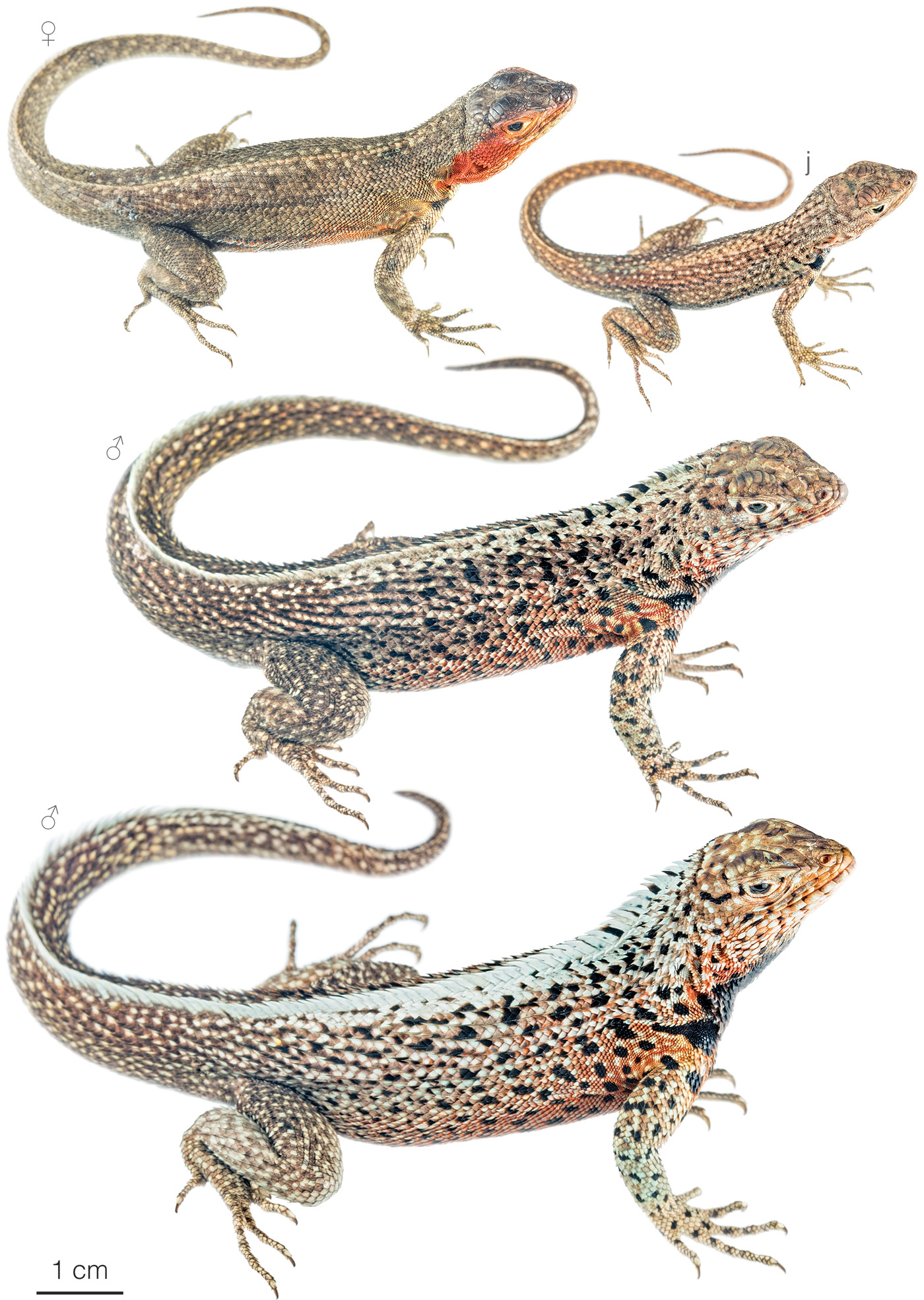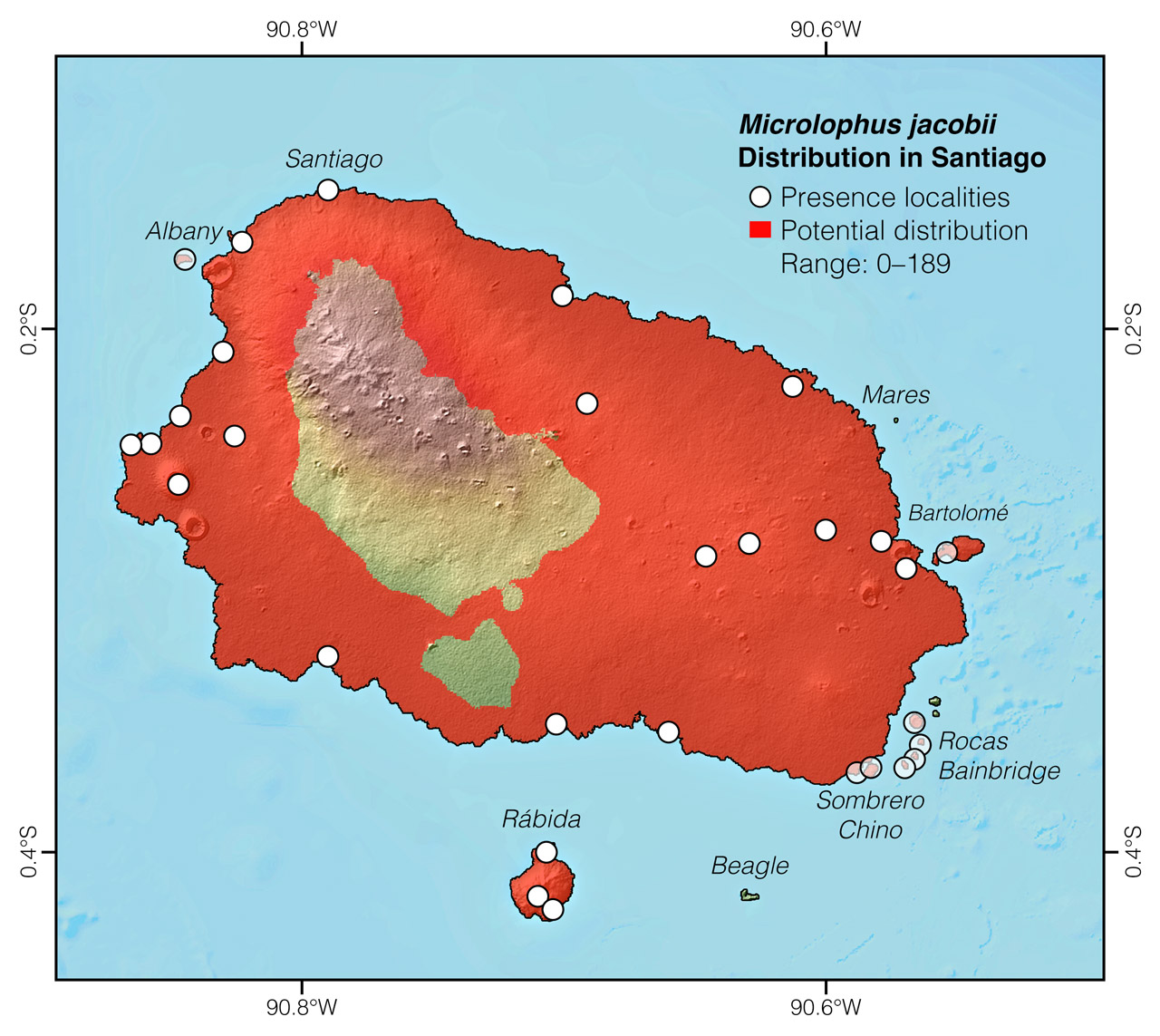Published October 10, 2019. Updated January 25, 2024. Open access. Peer-reviewed. | Purchase book ❯ |
Santiago Lava-Lizard (Microlophus jacobii)
Reptiles of Ecuador | Sauria | Tropiduridae | Microlophus jacobii
English common name: Santiago Lava-Lizard.
Spanish common name: Lagartija de lava de Santiago.
Recognition: ♂♂ 26.8 cmMaximum distance from the snout to the tip of the tail. Snout–vent length=8.2 cm. ♀♀ 19.1 cmMaximum distance from the snout to the tip of the tail. Snout–vent length=7.1 cm..1,2 Microlophus jacobii is easily distinguishable from other native lizards occurring on Floreana Island (that is, iguanas and leaf-toed geckos) by having keeled scales on the tail, a skin fold above the shoulder, a raised mid-dorsal crest, and a conspicuously enlarged interparietal scale.1 Microlophus jacobii is the only lava lizard occurring on Bartolomé, Santiago, Rábida, and six of the surrounding islets of these islands. Adult males are larger than females and easily recognized by their raised middorsal crest and distinctive black throat.1 Adult females can be recognized by their bright orange face and a black mark at the shoulder level (Fig. 1).1

Figure 1: Individuals of Microlophus jacobii from Playa Dorada, Santiago Island, Galápagos, Ecuador. j=juvenile.
Natural history: Microlophus jacobii is a diurnal lizard that inhabits volcanic rock areas, dry shrublands, and dry grasslands.1 During the early morning and late afternoon, Santiago Lava-Lizards are active on soil, rocks, shrubs, and cacti.1,3 To avoid the hot midday hours, they move into the shade, sitting on surfaces that have not been heated by the sun. At night, they remain hidden among rocks, beneath soil, and in leaf-litter. When threatened, these jittery reptiles flee into crevices or into tortoise (Chelonoidis darwini) nests.1 The diet in this species consists of insects, smaller lizards, and plant material such as leaves, fruits, and seeds.1,3,4 There are recorded instances of predation on members of this species, including by snakes (Pseudalsophis thomasi and P. hephaestus) and by introduced black rats.1,5 Males defend territories by performing pushup displays and by fighting with other males.1 Females lay 1–3 eggs3,6 in nests excavated in sandy substrate close to rocks or vegetation.7 They also protect the nests from potential predators and from other females.7
Conservation: Least Concern Believed to be safe from extinction given current circumstances..6 Microlophus jacobii is listed in this category because the species is not facing major immediate threats of extinction. Santiago Island is not populated by humans or major introduced lizard predators, such as cats, and the island is protected within the Galápagos National Park.6 However, Santiago Lava-Lizards are facing the threat of predation by introduced black rats.
Distribution: Microlophus jacobii is endemic to an area of approximately 463 km2 on Bartolomé, Santiago, and Rábida islands, as well as six of their surrounding islets (Albany, Rocas Bainbridge 3–6, and Sombrero Chino) in Galápagos, Ecuador (Figs 2, 3).

Figure 2: Distribution of Microlophus jacobii in Galápagos. See Appendix 1 for a complete list of the presence localities included in the map.

Figure 3: Distribution of Microlophus jacobii in Santiago Island. See Appendix 1 for a complete list of the presence localities included in the map.
Etymology: The generic name Microlophus comes from the Greek words mikros (=small) and lophos (=crest).1 The specific epithet jacobii refers to Santiago Island, previously known as James (=Jacobi in Latin) Island.1
See it in the wild: Santiago Lava-Lizards can be seen year-round with complete certainty on most tourism sites in and around Santiago Island, including Sombrero Chino Islet, Rábida Island, and Bartolomé Island.
Special thanks to Kim Harrell for symbolically adopting the Santiago Lava-Lizard and helping bring the Reptiles of Ecuador book project to life.
Click here to adopt a species.
Authors: Alejandro Arteaga,aAffiliation: Fundación Khamai, Reserva Arlequín, Ecoruta Paseo del Quinde km 56, Santa Rosa de Mindo, Pichincha 171202, Ecuador. Gabriela Aguiar,bIndependent researcher, Quito, Ecuador. and Juan M GuayasamincAffiliation: Universidad San Francisco de Quito, Quito, Ecuador.
Academic reviewers: Edgar Benavides,dAffiliation: Yale University, New Have, USA. John Rowe,eAffiliation: Alma College, Alma, USA. and Cruz MárquezfAffiliation: University of Rome Tor Vergata, Rome, Italy.
Photographer: Jose VieiragAffiliation: Tropical Herping (TH), Quito, Ecuador.,hAffiliation: ExSitu, Quito, Ecuador.
How to cite? Arteaga A, Aguiar G, Guayasamin JM (2024) Santiago Lava-Lizard (Microlophus jacobii). In: Arteaga A, Bustamante L, Vieira J (Eds) Reptiles of Ecuador: Life in the middle of the world. Available from: www.reptilesofecuador.com. DOI: 10.47051/MLEV3376
Literature cited:
- Arteaga A, Bustamante L, Vieira J, Tapia W, Guayasamin JM (2019) Reptiles of the Galápagos: life on the Enchanted Islands. Tropical Herping, Quito, 208 pp. DOI: 10.47051/AQJU7348
- Bowman RI (1966) Proceedings of the Symposia of the Galápagos International Scientific Project. University of California Press, Berkeley, 336 pp.
- Van Denburgh J, Slevin JR (1913) Expedition of the California Academy of Sciences to the Galápagos Islands, 1905-1906. IX. The Galapagoan lizards of the genus Tropidurus with notes on iguanas of the genera Conolophus and Amblyrhynchus. Proceedings of the California Academy of Sciences 2: 132–202.
- Hervías-Parejo S, Heleno R, Rumeu B, Guzmán B, Vargas P, Olesen JM, Traveset A, Vera C, Benavides E, Nogales M (2018) Small size does not restrain frugivory and seed dispersal across the evolutionary radiation of Galápagos lava lizards. Current Zoology 65: 353–361. DOI: 10.1093/cz/zoy066
- Cadena-Ortiz H, Barahona A, Bahamonde-Vinueza D, Brito J (2017) Anecdotal predation events of some snakes in Ecuador. Herpetozoa 30: 93–96.
- Márquez C, Cisneros-Heredia DF (2016) Microlophus jacobii. The IUCN Red List of threatened species. Available from: www.iucnredlist.org. DOI: 10.2305/IUCN.UK.2016-1.RLTS.T88793780A88793787.en
- Burger J (1993) Colony and nest site selection in lava lizards Tropidurus ssp. in the Galápagos Islands. Copeia 1993: 748–754. DOI: 10.2307/1447237
Appendix 1: Locality data used to create the distribution map of Microlophus jacobii in Ecuador (Fig. 2). Go to the section on symbols and abbreviations for a list of acronyms used.
| Country | Province | Locality | Source |
| Ecuador | Galápagos | Across Sombrero Chino | Benavides et al. 2009 |
| Ecuador | Galápagos | Bahía Ladilla | Hervías-Parejo 2018 |
| Ecuador | Galápagos | Bahía Sullivan | Benavides et al. 2009 |
| Ecuador | Galápagos | Bahía Sullivan, 1.6 km NW of | iNaturalist; photo examined |
| Ecuador | Galápagos | Bainbridge Roca 3 | Benavides et al. 2009 |
| Ecuador | Galápagos | Bainbridge Roca 4 | Benavides et al. 2009 |
| Ecuador | Galápagos | Bainbridge Roca 5 | Benavides et al. 2009 |
| Ecuador | Galápagos | Bainbridge Roca 6 | Benavides et al. 2009 |
| Ecuador | Galápagos | Cabo Stephens | iNaturalist; photo examined |
| Ecuador | Galápagos | Crater SW of Puerto Egas | iNaturalist; photo examined |
| Ecuador | Galápagos | Cumpleaños | Arteaga et al. 2019 |
| Ecuador | Galápagos | Ensenada Buccaneer | Benavides et al. 2009 |
| Ecuador | Galápagos | Isla Albany | Benavides et al. 2009 |
| Ecuador | Galápagos | Isla Bartolomé | Benavides et al. 2009 |
| Ecuador | Galápagos | La Bomba | Benavides et al. 2009 |
| Ecuador | Galápagos | La Bomba, 5 km S of | iNaturalist; photo examined |
| Ecuador | Galápagos | Mares, 5 km W of | iNaturalist; photo examined |
| Ecuador | Galápagos | Minas de Sal, 1 km E of | iNaturalist; photo examined |
| Ecuador | Galápagos | Mosquera, 8 km W of | iNaturalist; photo examined |
| Ecuador | Galápagos | Playa Dorada, 3 km W of | Arteaga et al. 2019 |
| Ecuador | Galápagos | Playa Dorada, 6 km W of | Arteaga et al. 2019 |
| Ecuador | Galápagos | Playa Espumilla | iNaturalist; photo examined |
| Ecuador | Galápagos | Puerto Egas | Arteaga et al. 2019 |
| Ecuador | Galápagos | Puerto Egas, 1 km NE | iNaturalist; photo examined |
| Ecuador | Galápagos | Puerto Egás, 1 km W of | iNaturalist; photo examined |
| Ecuador | Galápagos | Rábida Island, N tip | iNaturalist; photo examined |
| Ecuador | Galápagos | Rábida Island, near top | iNaturalist; photo examined |
| Ecuador | Galápagos | Rábida Island, south | iNaturalist; photo examined |
| Ecuador | Galápagos | Santiago, south beach | iNaturalist; photo examined |
| Ecuador | Galápagos | Sombrero Chino | iNaturalist; photo examined |